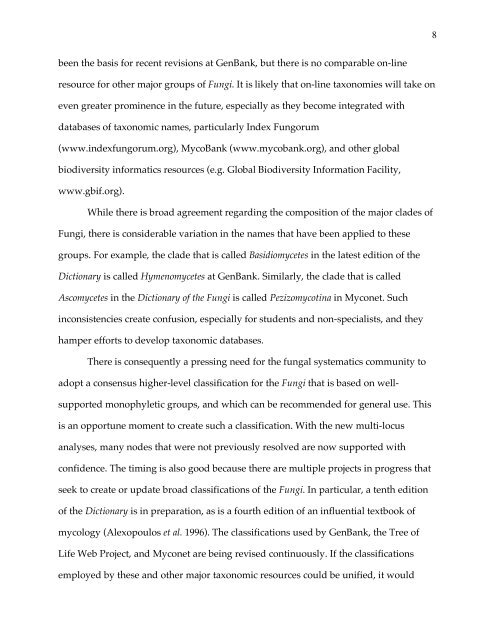Elsevier Editorial System(tm) for Mycological ... - Clark University
Elsevier Editorial System(tm) for Mycological ... - Clark University
Elsevier Editorial System(tm) for Mycological ... - Clark University
Create successful ePaper yourself
Turn your PDF publications into a flip-book with our unique Google optimized e-Paper software.
een the basis <strong>for</strong> recent revisions at GenBank, but there is no comparable on-line<br />
resource <strong>for</strong> other major groups of Fungi. It is likely that on-line taxonomies will take on<br />
even greater prominence in the future, especially as they become integrated with<br />
databases of taxonomic names, particularly Index Fungorum<br />
(www.indexfungorum.org), MycoBank (www.mycobank.org), and other global<br />
biodiversity in<strong>for</strong>matics resources (e.g. Global Biodiversity In<strong>for</strong>mation Facility,<br />
www.gbif.org).<br />
While there is broad agreement regarding the composition of the major clades of<br />
Fungi, there is considerable variation in the names that have been applied to these<br />
groups. For example, the clade that is called Basidiomycetes in the latest edition of the<br />
Dictionary is called Hymenomycetes at GenBank. Similarly, the clade that is called<br />
Ascomycetes in the Dictionary of the Fungi is called Pezizomycotina in Myconet. Such<br />
inconsistencies create confusion, especially <strong>for</strong> students and non-specialists, and they<br />
hamper ef<strong>for</strong>ts to develop taxonomic databases.<br />
There is consequently a pressing need <strong>for</strong> the fungal systematics community to<br />
adopt a consensus higher-level classification <strong>for</strong> the Fungi that is based on well-<br />
supported monophyletic groups, and which can be recommended <strong>for</strong> general use. This<br />
is an opportune moment to create such a classification. With the new multi-locus<br />
analyses, many nodes that were not previously resolved are now supported with<br />
confidence. The timing is also good because there are multiple projects in progress that<br />
seek to create or update broad classifications of the Fungi. In particular, a tenth edition<br />
of the Dictionary is in preparation, as is a fourth edition of an influential textbook of<br />
mycology (Alexopoulos et al. 1996). The classifications used by GenBank, the Tree of<br />
Life Web Project, and Myconet are being revised continuously. If the classifications<br />
employed by these and other major taxonomic resources could be unified, it would<br />
8
















